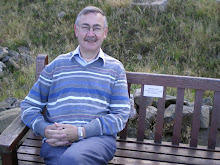

You wake up some mornings here to the smell of smoke from burning rubbish. Sadly the waste disposal system is not advanced here. Rubbish often lies where it is dropped, before being gathered into piles and burned. On the other hand, the Cameroonians are good at some practical recycling. Plastic bottles and containers which have served to carry palm oil for example are used to carry water. Tyres serve a number of purposes , e.g. as the bottom part of sandals.
I still can’t get used to bartering or haggling over the price of everything, and I’m actively looking for items with prices on them.
I still can’t get used to bartering or haggling over the price of everything, and I’m actively looking for items with prices on them.
There’s a strong woodworking tradition here. I’ve bought a piece of craftwork made from a hard red wood. The carver has produced a chain out of one piece of wood. It's strange to see coffins being manufactured uin the open air!
This morning I went with Rose to Mount Carmel Baptist Church in the Old Town. It was quite an experience. The service lasted from 8.3o a.m. to 11.30 a.m. The service didn’t have a clear beginning, and people kept arriving until the place was completely full - not a single seat left. Outside the Sunday school children met in two groups (one is shown here), while the adults had their Sunday school inside the church. Mount Carmel Baptist Church sits under the shadow of a huge mosque under construction. It is a one-story building with some naive art on the front wall.
The service was a seamless and joyous mix of prayers, hymns with a leader introducing the words and tune, then the congregation joining in. The two choirs, one using English on the front right, and one which sang in languages other than English, such as Oku, on the front left. Two or three drums were used at various times. There was no organ, but the singing was superb. I'm told that they learn to sing using the sol-fa method.
Just a few comments for fans of ecclesiology: there were practices which seemed a bit Anglican, such as the choirs processing in, singing, and the “passing the peace” (shaking hands with everyone within reach), while the spontaneous nature of the singing seemed a bit Pentecostal to me. For the hymns they used a hymnbook of Ida Sankey. What struck me was how much the congregation formed a family or a close community. A member who needed a blood transfusion was given blood donated by four church members, for example. A curious thing happened at the end of the service. Some worshippers were too poor to have any collection money, but they had brought things from their garden or store cupboard, three prickly pears and a bag of maize, for example, then these things were auctioned to raise real money for the church.
I went to visit Rose's home (pictured) - a one-roomed house, with a curtain dividing the room. She has the minimum of possessions and no running water in the house, but is contented, even cheerful. She also took me to meet her parents and her blind grandmother.

1 comment:
Kaj ĉe mia loka baptista preĝejo ni grumblas se la diservo pli longas ol unu horo!
Post a Comment